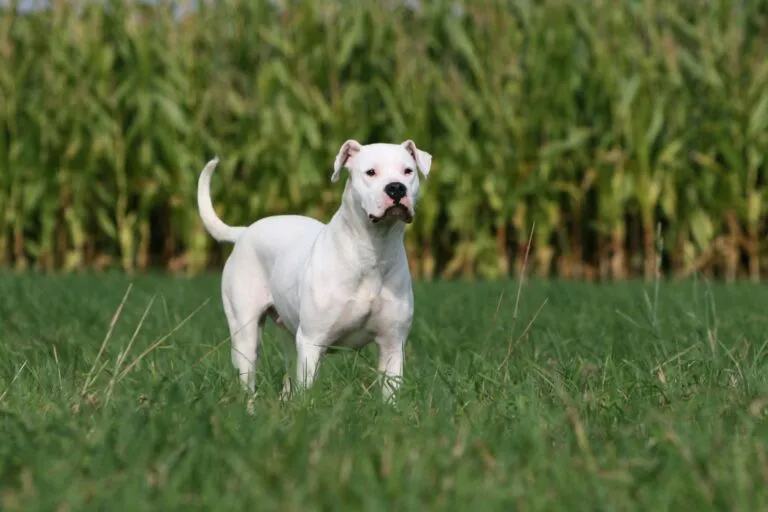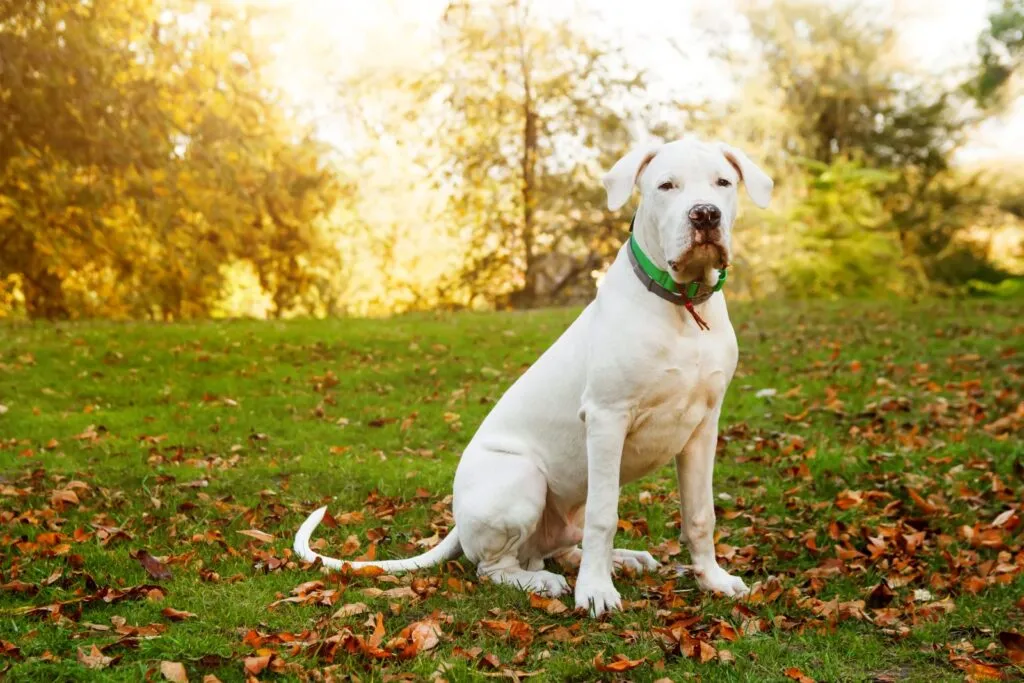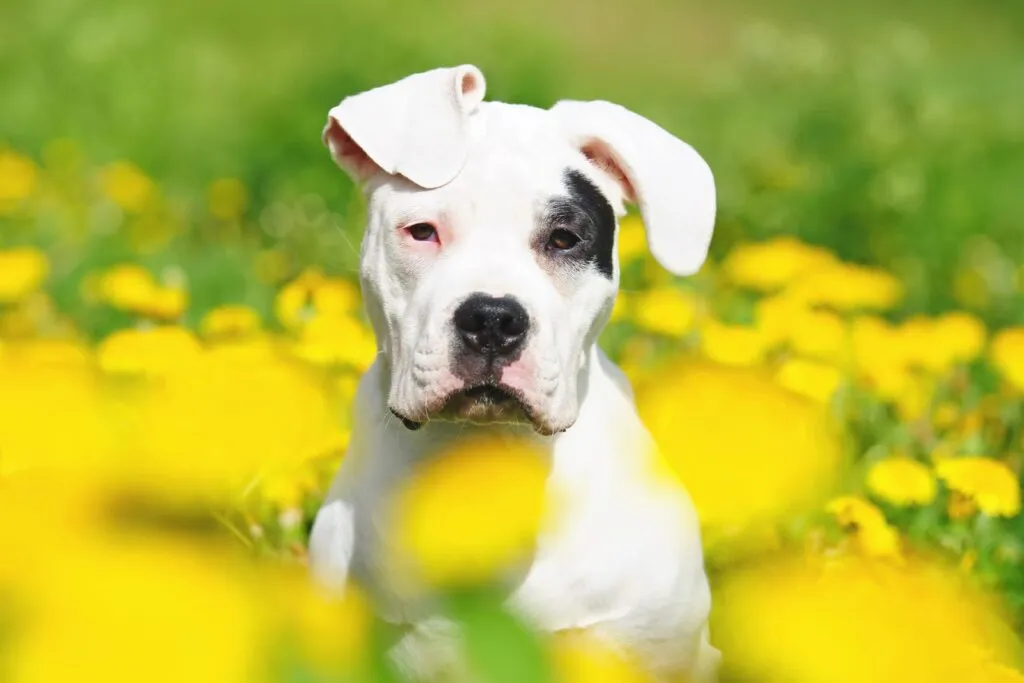Medium Size Poodle
The Dogo Argentino combines the traits of a hunting dog, guard dog, and family dog. Due to its strength and independent nature, it belongs only in experienced hands. In the UK, this is one of the banned dog breeds.

© Dogs / stock.adobe.com
The Dogo Argentino is a powerful presence and definitely not a dog for beginners.
Before reading this article, please be aware that owning a Dogo Argentino is illegal in the UK, along with other breeds such as the Japanese Tosa, Pit Bull Terrier, Fila Brasileiro, and Bully XL Dogs.
In addition to ownership restrictions, it is also against the law to sell, abandon, give away, or breed a banned dog breed. It is important to note that the ban is based on physical appearance as well. This means that even if a dog is not a Dogo Argentino or one of the mentioned breeds, it may still be classified as banned if its characteristics closely match those of a prohibited breed.
This article is for informational purposes only and is intended for pet enthusiasts and pet lovers. The zooplus Editorial Team always recommends checking national regulations and news, as well as consulting dog associations and clubs, to stay informed about the rules, updates, and processes specific to your region or country.
A fully grown male can reach a shoulder height of nearly 70cm and weigh up to 45kg.
Simply because of its size, the Dogo Argentino is an impressive sight. This is further highlighted by its compact, muscular body. Even a layperson can tell that this four-legged friend belongs to the mastiff family.
Its triangular ears are semi-erect and set low on the sides. The short fur is always pure white according to the standard. However, a dark spot on the head is permitted. Additionally, the coat on the head can be pigmented up to a maximum coverage of ten percent.
 © KsPhoto / stock.adobe.com
© KsPhoto / stock.adobe.com
Although its original purpose, wild boar hunting, has a very bloody background, the courageous Dogo Argentino is a cheerful and friendly dog. It knows how to handle its power well, making it a loyal family dog.
While loving within the pack and towards its close family members, it is distant with strangers. This territorial dog must not be encouraged to show any signs of aggression.
This breed displays pronounced hunting behaviour, which must always be controlled. A garden accessible to it must be absolutely escape-proof.
Despite its good guard dog qualities, this breed does not tend to bark excessively. However, it can exhibit intolerances, particularly when a male dog meets other males.
Overall, the Dogo Argentino is a very headstrong dog. If not led consistently by its owner, it will try to take control, which is problematic given its size.
A Dogo Argentino does not belong in the hands of beginners. It would exploit the smallest mistake to its advantage.
It can almost smell insecurity, leading to quick escalations of seemingly harmless beginner’s mistakes in dog training.
The breed requires firm and confident leadership. This should come from natural authority, not excessive harshness or violence.
Intensive socialisation during the puppy stage is crucial. This begins with a responsible breeder who introduces puppies early to human and dog interactions.
Socialisation continues in its new home. Attending puppy play sessions and later a dog school is advisable.
It’s beneficial if the Dogo Argentino grows up with other dogs. However, very dominant individuals may not be suitable for multi-dog households.
This breed descends from fighting dogs. In some places, it is therefore considered dangerous and classified as a ‘listed dog’
Besides the current ban in the UK, this also applies to holidays you may want to take with your new family member. In some countries like Denmark, Australia, and Norway, breeding and importing the Dogo Argentino are strictly regulated or banned.
A Dogo Argentino makes a fantastic companion if you are active and enjoy spending time outdoors. You should also be firm in training, ensuring the dog willingly follows your lead.
This breed doesn’t usually get along well with cats. However, cohabiting with a cat is possible if the puppy is used to cats early on.
 © Eudyptula / stock.adobe.com
© Eudyptula / stock.adobe.com
The Dogo Argentino loves extended activities in nature. It’s a great companion for long hikes. Once fully grown and gradually introduced to training, it also makes an excellent partner for jogging, horse riding, or cycling.
This powerhouse is naturally a great dog athlete. Discover together which sports suit you and your four-legged friend. Any form of nose work can be interesting for a Dogo Argentino. Repetitive exercises are less appealing to this independent hunter.
Large pond or lake nearby where the dog can swim without disturbing others? Great! Most of this breed love the water.
The short fur of a Dogo Argentino requires little care. Brush it several times a week. A fur-care glove or soft brush works well.
During shedding, people can brush the loose hair daily to reduce the amount of floating fur in your home.
Accustom your dog to the care routine as a puppy, so it enjoys it as an adult.
Clean your Dogo Argentino’s ears every two weeks with a special ear cleaner. You usually don’t need to bathe this dog. For heavy dirt, wash it with a mild dog shampoo. Most of the time, brushing out the dried dirt from the fur is enough.
In summer, having a swimming spot nearby is practical for your dog. Most love a dip in cool water, which also serves as a natural “dog wash.”
Keep an eye on your dog’s claws and shorten them if necessary with special claw clippers. Otherwise, the dog could get painfully snagged in everyday life.
A Dogo Argentino puppy should undergo an audiometric hearing test from six weeks old. Unfortunately, some are deaf in one or both ears. A breeder should never breed from a dog affected by deafness.
A dog who is deaf in one ear can still live a normal life. For those deaf in both ears, you need to understand the special needs of deaf dogs. Ideally, they live with other dogs to guide them.
Additionally, the ancestors of your potential Dogo Argentino should be tested negative for hip dysplasia. Large breeds, including this one, are predisposed to this hip joint malformation.
An X-ray can assess the hip condition, and dogs with affected hips should be removed from breeding programs.
Even with healthy hips, young dogs should avoid stairs and strenuous dog sports, which could harm their joints.
Continue the vaccination started in puppyhood with the adult Dogo Argentino. Discuss appropriate vaccination intervals and regular worming treatments with your vet.
Healthy dogs of this breed live an average of 10 to 15 years.
This breed can be prone to food intolerances, often manifesting as skin problems. A high-quality diet with substantial protein content is the safest option.
Offer your Dogo Argentino a chew treat now and then. Dried beef ears are a good choice.
Ensure treats also have high-quality ingredients. Many dogs love dried meat treats, which are both delicious and healthy.
If you need to switch food, do so gradually. Mix more of the new food with the old one each day to avoid sensitivity reactions.
Keep an eye on your dog’s weight. Overweight can cause many health issues, such as joint problems.
Give your Dogo Argentino a rest period after meals. Avoid strenuous activity post-meal as it increases the risk of gastric torsion, especially in large dogs.
Your dog should always have access to fresh water.
The origin of the Dogo Argentino is well documented. It is a relatively young breed. Dr Antonio Nores Martinez, the breed’s founder, developed the first standard in 1928.
Martinez intentionally crossed fighting dogs with mastiffs. Mastiffs had come to South America during the Spanish conquest.
His goal was simple: create an all-rounder. He wanted an outstanding hunting dog that also served as a family and guard dog.
Initially, the Dogo Argentino was mainly used for hunting wild boars and big cats. In wild boar hunts, dogs chase the prey in packs.
These Southern American mastiffs, including the Dogo Argentino, aim to bring down the prey. Due to its size and courage, the Dogo Argentino was perfect for this dangerous task.
These impressive dogs are also suitable as livestock guard dogs, protecting herds against numerous dangers.
The white fur of the dog hints at its original role. The bright fur keeps the Dogo Argentino from being mistaken for prey during a hunt and getting shot.
Today, it remains a popular all-rounder in its homeland, often living in families, just as Dr Martinez intended.
Fans of the Bearded Collie agree that those who aren't familiar with this dog breed simply have to get acquainted with it. And those who have experienced how a Bearded Collie bolts across meadows with its flowing fur, how it rolls around full of energy and joy and how it attentively and observantly takes into account its owners wishes become simply addicted to this original dog breed and its unique charm.
The Goldendoodle isn't a breed, but a pairing between Golden Retrievers and Medium or Standard Poodles. Marketed as a low-maintenance dog for allergy sufferers, this hybrid is enjoying increasing popularity amongst dog lovers, similar to the Labradoodle.